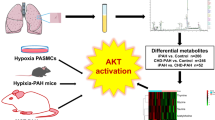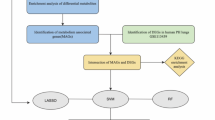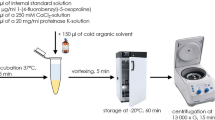Abstract
The quality of life and survival rates of patients with pulmonary arterial hypertension associated with congenital heart disease (CHD–PAH) have been greatly improved by defect-repair surgery and personalized treatments. However, those who survive surgery may remain at risk of persistent PAH, the prognosis may be considerably worse than those unoperated. Dynamic monitoring of clinical measures during the perioperative period of shunt correction is therefore indispensable and of great value. In this study, we explored the plasma-metabolite profiling in 13 patients with CHD–PAH during the perioperative period of defect repair. Plasma was harvested at four time points: prior to cardiopulmonary bypass (CPB) after anesthesia (Pre), immediately after CPB (T0), 24 h (T24), and 48 h (T48) after defect repair. Untargeted metabolomics strategy based on UPLC Q-TOF MS was used to detect the metabolites. A total of 193 distinguishing metabolites were determined at different time points, enriched in pathways such as oxidation of branched-chain fatty acids. We found that 17 metabolite alterations were significantly correlated with the reduction in mean pulmonary arterial pressure (MPAP) at T48 versus Pre. Gradients in diastolic pulmonary arterial pressure (DPAP), bicarbonate in radial artery (aHCO3), bicarbonate in superior vena cava (svcHCO3), and the partial pressure of dissolved CO2 gas in radial artery (aPCO2) were positively correlated with MPAP gradient. Notably, these clinical-measure gradients were correlated with alterations in shunt-correction-associated metabolites. In total, 12 out of 17 identified metabolites in response to defect repair were increased at both T24 and T48 (all P < 0.05, except propionylcarnitine with P < 0.05 at T24). In contrast, galactinol dihydrate, guanosine monophosphate, and hydroxyphenylacetylglycine tended to decline at T24 and T48 (only galactinol dihydrate with P < 0.05 at T48). In conclusion, 17 metabolites that respond to shunt correction could be used as suitable noninvasive markers, and clinical measures, including DPAP, aHCO3, svcHCO3, and aPCO2, would be of great value in disease monitoring and evaluating future therapeutic interventions.
Similar content being viewed by others
Log in or create a free account to read this content
Gain free access to this article, as well as selected content from this journal and more on nature.com
or
References
Galie N, Humbert M, Vachiery JL, Gibbs S, Lang I, Torbicki A, et al. 2015 ESC/ERS Guidelines for the diagnosis and treatment of pulmonary hypertension: The Joint Task Force for the Diagnosis and Treatment of Pulmonary Hypertension of the European Society of Cardiology (ESC) and the European Respiratory Society (ERS): Endorsed by: Association for European Paediatric and Congenital Cardiology (AEPC), International Society for Heart and Lung Transplantation (ISHLT). Eur Heart J. 2016;37:67–119.
Brida M, Gatzoulis MA. Pulmonary arterial hypertension in adult congenital heart disease. Heart. 2018;104:1568–74.
Drakopoulou M, Nashat H, Kempny A, Alonso-Gonzalez R, Swan L, Wort SJ, et al. Arrhythmias in adult patients with congenital heart disease and pulmonary arterial hypertension. Heart. 2018;104:1963–9.
Harries C, Armstrong I. A review of the management of pulmonary arterial hypertension associated with congenital heart disease. Eur J Cardiovasc Nurs. 2012;11:239–47.
Lowe BS, Therrien J, Ionescu-Ittu R, Pilote L, Martucci G, Marelli AJ. Diagnosis of pulmonary hypertension in the congenital heart disease adult population impact on outcomes. J Am Coll Cardiol. 2011;58:538–46.
Hoeper MM, Humbert M, Souza R, Idrees M, Kawut SM, Sliwa-Hahnle K, et al. A global view of pulmonary hypertension. Lancet Respir Med. 2016;4:306–22.
Gatzoulis MA, Alonso-Gonzalez R, Beghetti M. Pulmonary arterial hypertension in paediatric and adult patients with congenital heart disease. Eur Respir Rev. 2009;18:154–61.
Schuuring MJ, Vis JC, Duffels MG, Bouma BJ, Mulder BJ. Adult patients with pulmonary arterial hypertension due to congenital heart disease: a review on advanced medical treatment with bosentan. Ther Clin Risk Manag. 2010;6:359–66.
Talwar S, Keshri VK, Choudhary SK, Gupta SK, Ramakrishnan S, Juneja R, et al. Surgical strategies for patients with congenital heart disease and severe pulmonary hypertension in low/middle-income countries. Heart Asia. 2015;7:31–7.
Alonso-Gonzalez R, Lopez-Guarch CJ, Subirana-Domenech MT, Ruiz JMO, Gonzalez IO, Cubero JS, et al. Pulmonary hypertension and congenital heart disease: An insight from the REHAP National Registry. Int J Cardiol. 2015;184:717–23.
Beghetti M, Channick RN, Chin KM, Di Scala L, Gaine S, Ghofrani HA, et al. Selexipag treatment for pulmonary arterial hypertension associated with congenital heart disease after defect correction: insights from the randomised controlled GRIPHON study. Eur J Heart Fail. 2019;21:352–9.
Liu HM, Jia Y, Zhang YX, Yan J, Liao N, Li XH, et al. Dysregulation of miR-135a-5p promotes the development of rat pulmonary arterial hypertension in vivo and in vitro. Acta Pharmacol Sin. 2019;40:477–85.
Li Y, Yang L, Dong L, Yang ZW, Zhang J, Zhang SL, et al. Crosstalk between the Akt/mTORC1 and NF-kappaB signaling pathways promotes hypoxia-induced pulmonary hypertension by increasing DPP4 expression in PASMCs. Acta Pharmacol Sin. 2019;40:1322–33.
Blanche C, Alonso-Gonzalez R, Uribarri A, Kempny A, Swan L, Price L, et al. Use of intravenous iron in cyanotic patients with congenital heart disease and/or pulmonary hypertension. Int J Cardiol. 2018;267:79–83.
Kapoor PM, Subramanian A, Malik V, Devagorou V. Perioperative endothelin levels in patients undergoing intracardiac repair for tetralogy of Fallot. J Card Surg. 2014;29:670–7.
Varrica A, Satriano A, Gavilanes ADW, Zimmermann LJ, Vles HJS, Pluchinotta F, et al. S100B increases in cyanotic versus noncyanotic infants undergoing heart surgery and cardiopulmonary bypass (CPB). J Matern Fetal Neonatal Med. 2019;32:1117–23.
Jain P, Spaeder MC, Donofrio MT, Sinha P, Jonas RA, Levy RJ. Detection of alpha II-spectrin breakdown products in the serum of neonates with congenital heart disease*. Pediatr Crit Care Med. 2014;15:229–35.
Galie N, Humbert M, Vachiery JL, Gibbs S, Lang I, Torbicki A, et al. 2015 ESC/ERS Guidelines for the diagnosis and treatment of pulmonary hypertension: The Joint Task Force for the Diagnosis and Treatment of Pulmonary Hypertension of the European Society of Cardiology (ESC) and the European Respiratory Society (ERS): Endorsed by: Association for European Paediatric and Congenital Cardiology (AEPC), International Society for Heart and Lung Transplantation (ISHLT). Eur Respir J. 2015;46:903–75.
Chong J, Wishart DS, Xia J. Using MetaboAnalyst 4.0 for Comprehensive and integrative metabolomics data analysis. Curr Protoc Bioinforma. 2019;68:e86.
Fiehn O. Metabolomics–the link between genotypes and phenotypes. Plant Mol Biol. 2002;48:155–71.
Harbaum L, Rhodes CJ, Otero-Nunez P, Wharton J, Wilkins MR. The application of ‘omics’ to pulmonary arterial hypertension. Br J Pharmacol. 2021;178:108–20.
Kusonmano K, Vongsangnak W, Chumnanpuen P. Informatics for Metabolomics. Adv Exp Med Biol. 2016;939:91–115.
Zhao YD, Yun HZH, Peng J, Yin L, Chu L, Wu L, et al. De novo synthesize of bile acids in pulmonary arterial hypertension lung. Metabolomics. 2014;10:1169–75.
Lewis GD, Ngo D, Hemnes AR, Farrell L, Domos C, Pappagianopoulos PP, et al. Metabolic profiling of right ventricular-pulmonary vascular function reveals circulating biomarkers of pulmonary hypertension. J Am Coll Cardiol. 2016;67:174–89.
Rhodes CJ, Ghataorhe P, Wharton J, Rue-Albrecht KC, Hadinnapola C, Watson G, et al. Plasma metabolomics implicates modified transfer RNAs and altered bioenergetics in the outcomes of pulmonary arterial hypertension. Circulation. 2017;135:460–75.
Zhao JH, He YY, Guo SS, Yan Y, Wang Z, Ye J, et al. Circulating plasma metabolomic profiles differentiate rodent models of pulmonary hypertension and idiopathic pulmonary arterial hypertension patients. Am J Hypertens. 2019;32:1109–17.
He YY, Yan Y, Jiang X, Zhao JH, Wang Z, Wu T, et al. Spermine promotes pulmonary vascular remodelling and its synthase is a therapeutic target for pulmonary arterial hypertension. Eur Respir J. 2020;56:2000522.
Li M, Riddle S, Zhang H, D’Alessandro A, Flockton A, Serkova NJ, et al. Metabolic reprogramming regulates the proliferative and inflammatory phenotype of adventitial fibroblasts in pulmonary hypertension through the transcriptional corepressor C-terminal binding protein-1. Circulation. 2016;134:1105–21.
Talati MH, Brittain EL, Fessel JP, Penner N, Atkinson J, Funke M, et al. Mechanisms of lipid accumulation in the bone morphogenetic protein receptor type 2 mutant right ventricle. Am J Respir Crit Care Med. 2016;194:719–28.
La Frano MR, Fahrmann JF, Grapov D, Pedersen TL, Newman JW, Fiehn O, et al. Umbilical cord blood metabolomics reveal distinct signatures of dyslipidemia prior to bronchopulmonary dysplasia and pulmonary hypertension. Am J Physiol Lung Cell Mol Physiol. 2018;315:L870–81.
Rafikova O, Meadows ML, Kinchen JM, Mohney RP, Maltepe E, Desai AA, et al. Metabolic changes precede the development of pulmonary hypertension in the monocrotaline exposed rat lung. PLoS One. 2016;11:e0150480.
Sun X, Lu Q, Yegambaram M, Kumar S, Qu N, Srivastava A, et al. TGF-beta1 attenuates mitochondrial bioenergetics in pulmonary arterial endothelial cells via the disruption of carnitine homeostasis. Redox Biol. 2020;36:101593.
Xu XQ, Jing ZC, Jiang X, Zhao QH, He J, Dai LZ, et al. Clinical efficacy of intravenous L-carnitine in patients with right-sided heart failure induced by pulmonary arterial hypertension. Zhonghua Xin Xue Guan Bing Za Zhi. 2010;38:152–5.
Fevery J. Bilirubin in clinical practice: a review. Liver Int. 2008;28:592–605.
Xu XQ, Lv ZC, Liu QQ, Zhao QH, Wu Y, Sun K, et al. Direct bilirubin: A new risk factor of adverse outcome in idiopathic pulmonary arterial hypertension. Int J Cardiol. 2017;228:895–9.
Takeda Y, Takeda Y, Tomimoto S, Tani T, Narita H, Kimura G. Bilirubin as a prognostic marker in patients with pulmonary arterial hypertension. BMC Pulm Med. 2010;10:22.
Hemnes AR, Luther JM, Rhodes CJ, Burgess JP, Carlson J, Fan R, et al. Human PAH is characterized by a pattern of lipid-related insulin resistance. JCI Insight. 2019;4:e123611.
Swietlik EM, Ghataorhe P, Zalewska KI, Wharton J, Howard LS, Taboada D, et al. Plasma metabolomics exhibit response to therapy in chronic thromboembolic pulmonary hypertension. Eur Respir J. 2020;57:2003201.
Sutendra G, Bonnet S, Rochefort G, Haromy A, Folmes KD, Lopaschuk GD, et al. Fatty acid oxidation and malonyl-CoA decarboxylase in the vascular remodeling of pulmonary hypertension. Sci Transl Med. 2010;2:44ra58.
Knirsch W, Eiselt M, Nurnberg J, Haas NA, Berger F, Dahnert I, et al. Pulmonary plasma catecholamine levels and pulmonary hypertension in congenital heart disease. Z Kardiol. 2002;91:1035–43.
Izquierdo-Garcia JL, Arias T, Rojas Y, Garcia-Ruiz V, Santos A, Martin-Puig S, et al. Metabolic reprogramming in the heart and lung in a murine model of pulmonary arterial hypertension. Front Cardiovasc Med. 2018;5:110.
Acknowledgements
We are grateful to the clinical staff for their contributions in sample collection and all participants involved in this study. We thank Dr. Tanzilan Nahar from the University of Illinois at Chicago for polishing the paper. This work was supported by the 13th Five-Year Plan—Precise Medicine—Key Research and Development Program—Clinical Cohort of Rare Disease (2016YFC0901500), Projects of National Natural Science Foundation of China (81630003, 82170058), Science Foundation for Outstanding Young Scholars of Henan Province (212300410027), Key Project of Ningxia Hui Autonomous Region (2019BFG02027), and Project of Braun Research Foundation (T2017-ZX029).
Author information
Authors and Affiliations
Contributions
YYH contributed to the study’s design and conduction, provided funding support, data interpretation, and paper preparation; YY contributed to the study’s design and conduction, data analyses, data interpretation, and paper preparation; JWC contributed to the study’s design and data interpretation; SL and LH collected clinical samples; XJ, XQX, and DL assisted in data analysis and figure preparation. ZCJ provided funding support and revised the paper. FXY participated in the study design and revised the manuscript. ZYH conceived, supervised, and designed the study, provided funding support and wrote the paper.
Corresponding author
Ethics declarations
Competing interests
The authors declare no competing interests.
Supplementary information
Rights and permissions
About this article
Cite this article
He, Yy., Yan, Y., Chen, Jw. et al. Plasma metabolomics in the perioperative period of defect repair in patients with pulmonary arterial hypertension associated with congenital heart disease. Acta Pharmacol Sin 43, 1710–1720 (2022). https://doi.org/10.1038/s41401-021-00804-3
Received:
Accepted:
Published:
Issue date:
DOI: https://doi.org/10.1038/s41401-021-00804-3



